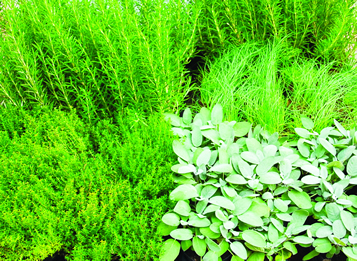Herbal Spotlight: Sage It’s also delicious. While a short Internet search can provide a variety of medicinal preparations that use sage, with the holiday season approaching, I’m going to go with Hippocrates and say “Let food be your medicine” with a recipe for a traditional wintery culinary herb mix that relies heavily on sage. Don’t be fooled by the name! Poultry seasoning isn’t just for poultry! According to foodnetwork.com poultry seasoning can “…spruce up classic roasted vegetables (think Brussels sprouts, carrots, and potatoes). For apps and salads, try mixing a tablespoon of poultry seasoning with Greek yogurt to make a dip for a crudité platter, or whisk some seasoning with lemon juice, salt, and olive oil to make salad dressing. Take things sweet by sautéing apple wedges with butter, honey and poultry seasoning until golden and serve the lot alongside a cheese plate. …[use] poultry seasoning in a compound butter to serve with Parker House rolls, or even in a morning-after-Thanksgiving quiche. Or use it to bolster chestnut-studded corn muffins.” It’s a seasoning with a strong, earthy and astringent flavor, so go easy with it until you know what you like. For example, try adding 1 to 2 tsp. to 4 cups bread cubes for traditional Thanksgiving stuffing, or with some oil to a pan of roasting vegetables. This mix doesn’t contain salt, so you’ll still need to salt whatever you’re making with it according to your taste. Poultry Seasoning 3 T ground sage If you are using whole herbs rather than powdered, place everything in a spice grinder or mortar and pestle and process until you have a fine powder. Store the mix in a glass jar with a tight lid in your pantry. Properly stored, it should last up to a year – after that it will probably still be good but might not have as much flavor or nutritional value, as the volatile oils in the herbs degrade over time. Note: While sage is generally recognized as safe for culinary use, it should not be consumed in large amounts or used medicinally without professional supervision. As always, the content in this article is meant to inform, not to diagnose or treat any ailment. Always use common sense, and consult with your healthcare provider before attempting to treat yourself or others. ♥ top | Newsletter Home |Table of Contents| Archive
|


 Sage (Salvia officinalis) is a perennial evergreen
shrub in the mint family, with silvery-green
leaves, a pungent scent, and woody stems. A
native of the Mediterranean, sage grows well
almost everywhere, and is considered a “sister
herb” to potent rosemary (bearing the same medicinal
powerhouse rosmarinic acid as well as
other beneficial compounds) and has become
an important part of traditional medicine all
over the world (varieties with different properties
include Spanish sage (Salvia lavandulaefolia),
Chinese sage (Salvia miltiorrhiza), and
White Sage (Salvia apiana). Most uses involve
ingesting the leaves by chewing them or creating
a tea, tincture, or extract; or creating a topical
application such as a salve, to apply to the
skin. Extensive research has shown that sage
has potent anti-inflammatory and antioxidant
effects, can improve memory retention, has antibacterial
action (particularly as a mouthwash
to prevent dental decay), contains high amounts
of bone-strengthening vitamin K (100g provides
almost a third of the US-RDA), can mitigate the
symptoms of menopause, soothes skin conditions,
helps control blood sugar fluctuations,
lowers cholesterol levels, and improves digestion.
Sage (Salvia officinalis) is a perennial evergreen
shrub in the mint family, with silvery-green
leaves, a pungent scent, and woody stems. A
native of the Mediterranean, sage grows well
almost everywhere, and is considered a “sister
herb” to potent rosemary (bearing the same medicinal
powerhouse rosmarinic acid as well as
other beneficial compounds) and has become
an important part of traditional medicine all
over the world (varieties with different properties
include Spanish sage (Salvia lavandulaefolia),
Chinese sage (Salvia miltiorrhiza), and
White Sage (Salvia apiana). Most uses involve
ingesting the leaves by chewing them or creating
a tea, tincture, or extract; or creating a topical
application such as a salve, to apply to the
skin. Extensive research has shown that sage
has potent anti-inflammatory and antioxidant
effects, can improve memory retention, has antibacterial
action (particularly as a mouthwash
to prevent dental decay), contains high amounts
of bone-strengthening vitamin K (100g provides
almost a third of the US-RDA), can mitigate the
symptoms of menopause, soothes skin conditions,
helps control blood sugar fluctuations,
lowers cholesterol levels, and improves digestion.